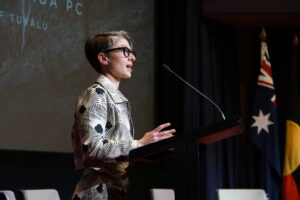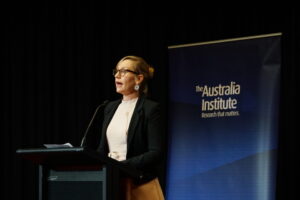by Ebony Bennett
[Originally published in The Canberra Times, 08 February 2020]
There’s a hole where Australia’s climate and energy policy should be and the Morrison Government just keeps digging. The cheapest, cleanest solutions are right in front of its nose and yet it keeps subsidising the problem.
In the face of a climate-fuelled bushfire crisis the Prime Minister himself dubbed ‘Black Summer’ (never mind that the bushfire season started last winter), Scott Morrison announced that the government will provide a taxpayer subsidy to burn more fossil fuels – namely gas in NSW. Not only does this decision contribute to the problem, accelerating the danger of future bushfires seasons, it’s also a bad decision for consumers.
It’s hard to argue that Australia is transitioning to a low emissions future, as the Treasurer keeps asserting, when the government keeps announcing new gas and coal projects. A transition normally implies moving from one state of being to another, so until we stop approving new gas and coal projects there is no meaningful transition taking place. Burning more gas to reduce emissions is like switching from Big Macs to cheeseburgers to lose weight, it might be slightly fewer calories, but it’s still junk food.
The Prime Minister is between the same dumb-as-a-rock (climate deniers) and hard place (science) as all previous Liberal Prime Ministers who have been undone by the wicked internal politics of climate change. But that doesn’t explain why it’s making dumb economic decisions.
The $2 billion energy deal the Prime Minister announced with NSW included plans to inject an additional 70 petajoules of gas per year into the east coast energy market and an undertaking from the NSW Government to remove barriers to coal supply. In other words, burning both more gas and more coal. So far, so bad for future bushfire seasons.
But gas is dangerous for global warming and bad for consumers’ hip pockets. Plenty of people, myself included, have outlined why investing in fossil fuels is dangerous, but it’s also worth examining why consumers should be worried about the gas deal. The Coalition likes to talk about bringing down energy costs, yet it keeps picking the most expensive options – do as little as possible, as late as possible, using the most expensive technology.
Since Australia’s small, relatively cheap domestic gas market was connected to the global gas market a few years back, the gas price for Australian consumers has tripled, just as Australia Institute research warned it would. Gas prices skyrocketed so high that they threatened east coast manufacturing with closure or moving offshore – this was happening as gas production increased dramatically. So at the time as Australia is producing more gas than ever, it’s also more expensive than ever. Heads gas executives win, tails you lose.
Gas would not be the first pick if you were trying to help consumers’ hip pockets – the cheapest options are renewables, energy efficiency and things like demand response. Australia Institute research shows that mythical ‘clean coal’ does not exist at commercial scale anywhere in Australia, despite over a billion dollars of Australian government spending on carbon capture and storage projects since 2003. If coal is washed to make it ‘clean’, coal costs go up even more. Gas is slightly less expensive to build than a new coal-burning power plant, but it costs more to run because gas is so expensive. Nuclear power, a favourite of Barnaby Joyce and Angus Taylor, is not only the most expensive form of new energy to build (requiring billions of dollars of taxpayer subsidies) but it would take decades to build, making it a uniquely poor choice to reduce emissions or electricity prices within the next 20 years.
Even ignoring expensive coal, mythical carbon capture and storage and hypothetical nuclear power, as Tim Buckley of IEEFA succinctly put it: high-priced gas is not going to provide low-cost electricity.
Put simply: renewables are cheaper to build and run and better for consumers and the planet. The government has not totally ignored renewables in the NSW energy deal, which includes a pilot renewable energy zone as well as funding to improve transmission and grid reliability. But it’s a token investment compared to what the government is proposing to invest in gas.
Apparently, while the gas industry gets the certainty of demanding 70 petajoules of gas per year, investment in renewables will be left to crash further – just as it did under Tony Abbott.
It makes no economic sense. While the price of gas tripled in Australia since 2010, the price of renewables dropped significantly. The cost of battery-supplied electricity fell nearly 80 per cent in 2017 alone. The 2019 Bloomberg New Energy Finance New Energy Outlook reported that since 2010 the price of solar fell by 85%, wind by 49% and batteries by 85%.
Cheaper still than building new power plants, is reducing demand and increasing energy efficiency so we don’t need to build new supply – an inherently conservative approach. In 2018, the Australia Institute, the Public Interest Advocacy Centre and the Total Environment Centre proposed a rule change to the National Electricity Market rules to introduce wholesale demand response.
Wholesale demand response is a system where the wholesale electricity market pays energy users to cut their energy use, instead of turning on more expensive generators, when demand and wholesale prices are high – think of a market of ‘negawatts’ or avoided energy use, as opposed to needing to supply additional ‘megawatts’. Under the AEMC draft rule, industry and business users involved will receive a direct financial benefit, but all consumers benefit from downward pressure on electricity prices. This scheme could, and should, be extended to households as soon as possible to help you make money by using less energy, while reducing demand on the electricity grid and saving emissions. It’s a win/win/win.
A majority of Australians, from every political persuasion, support renewables. Which makes them roughly as popular as having a BBQ on a public holiday. But gas and coal projects are contentious and have a tendency to divide communities where they encroach on land and threaten water quality.
Politically, the NSW gas deal is risky for the Nationals. Let’s not forget, re-elected Nationals Leader Michael McCormack could not name a single, big policy area where the Nationals sided with the interests of farmers over the interests of miners when they’ve come into conflict, when asked by The Project’s Waleed Aly last year. The proposed 70 petajoule Santos Narrabri gasfield involves drilling close to 900 gas wells, which could potentially de-water the aquifers beneath a recharge aquifer of the Great Artesian Basin.
Understandably, this is of huge concern to farmers and regional communities during a damaging drought, where regional towns are running out of water. It wasn’t so long ago that farmers and communities were so opposed to rapacious gas and coal projects on the land it sparked a campaign called Lock The Gate, where farmers literally locked their gates, refusing access to gas companies and refusing to negotiate sale of their properties to coal companies. Does the government imagine
rural communities will be less concerned about the impacts of mining on water during this drought than they were when water was more plentiful?
Our communities, our bush and unique native animals, our agriculture and tourism sectors and our economy more broadly have been devastated by the fires. Bushfire-affected communities, in particular, are owed something better than this business-as-usual approach that delivered us this Black Summer.
Ebony Bennett is the deputy director at independent think-tank The Australia Institute @ebony_bennett
Between the Lines Newsletter
The biggest stories and the best analysis from the team at the Australia Institute, delivered to your inbox every fortnight.
You might also like
Australia’s Climate of Discontent
Australia gives more aid to foreign fossil fuel companies than it does to our neighbours in the Pacific.
The Climate Crisis is an Integrity Crisis | Polly Hemming
I am starting my address to this year’s summit in the exact same way that I started last year’s address. Because it is just over a year since I delivered these same words, which aren’t actually my words. They are the words of our Climate Change Minister, and they provide a baseline of sorts for what progress has been made in that time.
Removing the Fossil Fuel Industry’s Influence on Politics and Parliament | Senator Larissa Waters
Removing the fossil fuel industry’s influence on politics and parliament is how we change the story and restore trust in government decisions.

